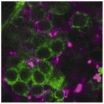(Press-News.org) Restricting red blood cell (RBC) transfusions among hospitalized patients to those with hemoglobin (the iron-containing protein in RBCs) measures below a certain level is associated with a lower risk of health care-associated infections, according to a study in the April 2 issue of JAMA.
Efforts to prevent health care-associated infection are among the priorities for the U.S. Department of Health and Human Services. The estimated annual direct medical costs of health care-associated infections to U.S. hospitals ranges from $28 billion to $45 billion, with about 1 in every 20 inpatients developing an infection related to their hospital care. Transfusion of RBCs is a common inpatient therapy, with approximately 14 million units transfused in 2011 in the United States, according to background information in the article. One potential approach to reducing the risk of infection associated with transfusions is lowering the hemoglobin thresholds (levels) at which RBC transfusions are indicated, so-called restrictive threshold strategies. The association between RBC transfusion strategies and health care-associated infection is not fully understood.
Jeffrey M. Rohde, M.D., of the University of Michigan, Ann Arbor, and colleagues compared restrictive vs liberal RBC transfusion strategies to evaluate their association with the risk of health care-associated infection. The study consisted of a review and meta-analysis of the data from 21 randomized trials with 8,735 patients who underwent transfusion; 18 trials (n = 7,593 patients) contained sufficient information for inclusion in the meta-analyses. The main outcomes measured for the analysis were the incidence of health care-associated infection such as pneumonia, mediastinitis (inflammation of tissue in the chest cavity), wound infection, and sepsis.
The researchers found that for those patients receiving the restrictive transfusion strategies, the risk of infection (for all serious infections) was 11.8 percent, and for patients receiving the liberal transfusion strategies, was 16.9 percent. Even with a reduction in the level of white blood cells (via the processing of blood), the risk of infection remained reduced with a restrictive strategy. The meta-analysis of randomized trials suggested that for every 1,000 patients in which RBC transfusion is under consideration, 26 could potentially be spared an infection if restrictive strategies were used.
The authors found no significant differences in the incidence of infection by RBC threshold for patients with cardiac disease, the critically ill, those with acute upper gastrointestinal bleeding, or for infants with low birth weight. The risk of infection was lower in patients undergoing orthopedic surgery or with sepsis and who received a restrictive transfusion strategy.
The authors write that the results of this review provide further support to a recent systematic review and clinical practice guideline put forth by the AABB (formerly the American Association of Blood Banks), that recommends adherence to a restrictive transfusion strategy for the majority of hospitalized patients and lists specific hemoglobin-based recommendations for different patient populations.
(doi:10.1001/jama.2014.2726; Available pre-embargo to the media at http://media.jamanetwork.com)
Editor's Note: This work was funded by a grant from the National Heart, Lung, and Blood Institute. Please see the article for additional information, including other authors, author contributions and affiliations, financial disclosures, etc.
Editorial: Blood Transfusion and Risk of Infection - New Convincing Evidence
Jeffrey L. Carson, M.D., of the Rutgers Robert Wood Johnson Medical School, New Brunswick, N.J., comments on this study in accompanying editorial.
"The only outcome evaluated in the report by Rohde et al was infection risk. However, other important outcomes such as mortality, myocardial infarction, and function should be considered in the overall risk-benefit analysis of transfusion."
"The study by Rohde et al confirms another potential adverse outcome associated with transfusion: serious infectious disease. Clinical trials are needed to establish the optimal transfusion thresholds, to provide additional information about the risks and benefits of RBC transfusion, and to determine how best to use RBC transfusion."
(doi:10.1001/jama.2014.2727; Available pre-embargo to the media at http://media.jamanetwork.com)
Editor's Note: The author has completed and submitted the ICMJE Form for Disclosure of Potential Conflicts of Interest. Dr. Carson reports serving as a consultant to Cerus for a trial unrelated to this article and reports grant funding to his institution from the National Institutes of Health.
INFORMATION: END
Outcomes of administering blood transfusions to patients with lower levels of hemoglobin
2014-04-01
ELSE PRESS RELEASES FROM THIS DATE:
The potential conflict of interest for leaders of AMCs serving on pharmaceutical boards
2014-04-01
About 40 percent of pharmaceutical company boards of directors examined had at least one member who held a leadership position at an academic medical center, with annual compensation for these positions averaging approximately $300,000, according to a study in the April 2 issue of JAMA.
"Financial relationships between the pharmaceutical industry and physicians have come under increased scrutiny. Less attention has been paid to relationships between industry and the leadership of academic medical centers (AMCs), who wield considerable influence over research, clinical, ...
Experts question routine mammograms in elderly
2014-04-01
Doctors should focus on life expectancy when deciding whether to order mammograms for their oldest female patients, since the harms of screening likely outweigh the benefits unless women are expected to live at least another decade, according to a review of the scientific literature by experts at UCSF and Harvard medical schools.
National guidelines recommend that doctors make individualized screening decisions for women 75 and older. But the analysis, published online Tuesday in JAMA (March 31, 2014), concluded that since this age group was not included in mammography ...
Night owls, unlike early birds, tend to be unmarried risk-takers
2014-04-01
Women who are night owls share the same high propensity for risk-taking as men, according to a recent study by a University of Chicago professor.
The research suggests that sleep patterns are linked with important character traits and behavior, said study author Dario Maestripieri, professor in Comparative Human Development. Night owls—people who tend to stay up late and wake up late in the morning—are different in many important ways from early risers, he found.
"Night owls, both males and females, are more likely to be single or in short-term romantic relationships ...
Like hand-washing, blood transfusions linked to infections
2014-04-01
Blood transfusions are among the most common treatments for hospitalized patients nationwide, but doing them less often reduces infection rates by nearly 20 percent, according to a study in the Journal of the American Medical Association co-authored by Neil Blumberg, M.D., professor at the University of Rochester School of Medicine and Dentistry.
As director of transfusion medicine and the blood bank at UR Medicine, Blumberg for more than 25 years has been investigating how to make blood transfusions safer. The JAMA study is the first to show conclusively, through a study ...
A protein could be a key weapon in the battle of the bulge
2014-04-01
Bethesda, MD (April 1, 2014)— More than one-third of people in the US are obese. Obesity and its related health problems—including high blood pressure, high cholesterol, diabetes, insulin resistance, and belly fat—affect so many, yet effective treatments are very few. In a new study, Simon Musyoka Mwangi and colleagues tested whether higher levels of a certain protein help fight the weight gain and health problems caused by eating the wrong foods.
Glial cell line-derived neurotrophic factor—or GDNF for short—is a protein integral to keeping the body's systems in balance ...
Adult tonsillectomy complications and health care expenses
2014-04-01
A study released today of 36,210 adult tonsillectomy patients finds that 20 percent will have a complication, offering valuable new insights to a decades long discussion. The study, featured in the April 2014 issue of Otolaryngology—Head and Neck Surgery, examines the prevalence of complications in adult tonsillectomies and the impact on health care expenditures.
"Researchers have been examining variation in tonsillectomy for years," explained corresponding author, Dennis Scanlon, PhD. "Yet most research has been documented in pediatric populations. Much less is known ...
Deforestation of sandy soils a greater climate threat
2014-04-01
Deforestation may have far greater consequences for climate change in some soils than in others, according to new research led by Yale University scientists — a finding that could provide critical insights into which ecosystems must be managed with extra care because they are vulnerable to biodiversity loss and which ecosystems are more resilient to widespread tree removal.
In a comprehensive analysis of soil collected from 11 distinct U.S. regions, from Hawaii to northern Alaska, researchers found that the extent to which deforestation disturbs underground microbial ...
Researchers identify similarities between HIV/AIDS and opioid addiction epidemics
2014-04-01
(PROVIDENCE, R.I.) – There are important parallels between the early years of the HIV/AIDS epidemic and the current epidemic of opioid addiction - ones that could trigger a significant shift in opioid addiction prevention, diagnosis and treatment.
These are the findings of a comparative review of HIV/AIDS and addiction by researchers Josiah D. Rich, M.D., M.P.H., director of the Center for Prisoner Health and Human Rights, based at The Miriam Hospital; Traci C. Green, Ph.D., MSc, Department of Emergency Medicine at Rhode Island Hospital and assistant professor of Emergency ...
Study reveals animal research bias in experimentation oversight committee membership
2014-04-01
Denver — Committees that are federally mandated to review, approve, and monitor the use of animals in experiments—called Institutional Animal Care and Use Committees (IACUC)—are dominated by animal research interests, according to a study presented today (Wednesday April 2) at the 2014 Public Responsibility in Medicine and Research (PRIM&R) IACUC Conference in Denver.
Using the federal Freedom of Information Act, researchers from People for the Ethical Treatment of Animals (PETA) and the University of California–San Diego School of Medicine obtained the current IACUC ...
Fruitfly study: Epilepsy drug target implications for sleep disruption in brain disorders
2014-04-01
PHILADELPHIA — A new study in a mutant fruitfly called sleepless (sss) confirmed that the enzyme GABA transaminase, which is the target of some epilepsy drugs, contributes to sleep loss. The findings, published online in Molecular Psychiatry, were led by Amita Sehgal, PhD, head of the Chronobiology Program at the University of Pennsylvania's Perelman School of Medicine. The findings shed light on mechanisms that may be shared between sleep disruption and some neurological disorders. A better understanding of this connection could enable treatments that target both types ...

